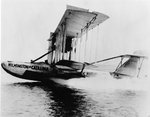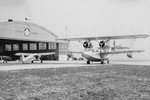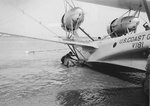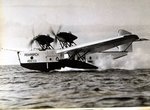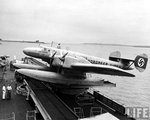Navigation
Install the app
How to install the app on iOS
Follow along with the video below to see how to install our site as a web app on your home screen.
Note: This feature may not be available in some browsers.
More options
You are using an out of date browser. It may not display this or other websites correctly.
You should upgrade or use an alternative browser.
You should upgrade or use an alternative browser.
If It Can Fly, It Can Float!!!
- Thread starter Njaco
- Start date
Ad: This forum contains affiliate links to products on Amazon and eBay. More information in Terms and rules
More options
Who Replied?Aaron Brooks Wolters
Brigadier General
Found another. Curtiss HS-2L Pacific Marine Airways.
PictionID:43264643 - Title:Curtiss HS-2L Pacific Marine Airways [Western AL via RJF] - Catalog:17_000273 - Filename:17_000273.tif - ———Image from the René Francillon Photo Archive. Having had his interest in aviation sparked by being at the receiving end of B-24s bombing occupied France when he was 7-yr old, René Francillon turned aviation into both his vocation and avocation. Most of his professional career was in the United States, working for major aircraft manufacturers and airport planning/design companies. All along, he kept developing a second career as an aviation historian, an activity that led him to author more than 50 books and 400 articles published in the United States, the United Kingdom, France, and elsewhere. Far from "hanging on his spurs," he plans to remain active as an author well into his eighties.——-PLEASE TAG this image with any information you know about it, so that we can permanently store this data with the original image file in our Digital Asset Management System.————–SOURCE INSTITUTION: San Diego Air and Space Museum Archive
PictionID:43264643 - Title:Curtiss HS-2L Pacific Marine Airways [Western AL via RJF] - Catalog:17_000273 - Filename:17_000273.tif - ———Image from the René Francillon Photo Archive. Having had his interest in aviation sparked by being at the receiving end of B-24s bombing occupied France when he was 7-yr old, René Francillon turned aviation into both his vocation and avocation. Most of his professional career was in the United States, working for major aircraft manufacturers and airport planning/design companies. All along, he kept developing a second career as an aviation historian, an activity that led him to author more than 50 books and 400 articles published in the United States, the United Kingdom, France, and elsewhere. Far from "hanging on his spurs," he plans to remain active as an author well into his eighties.——-PLEASE TAG this image with any information you know about it, so that we can permanently store this data with the original image file in our Digital Asset Management System.————–SOURCE INSTITUTION: San Diego Air and Space Museum Archive
Attachments
Aaron Brooks Wolters
Brigadier General
Aaron Brooks Wolters
Brigadier General
fubar57
General
Nice shots Aaron.
Geo
Geo
Good shots guys!
Aaron Brooks Wolters
Brigadier General
Thank you George. Found most of these on Tumblr.
Vic Balshaw
Major General
Yep. GB22 – Seaplanes-Floatplanes WWII.
vikingBerserker
Lieutenant General
Beautiful gents!
I wonder what happened to the Hall company. They built some pretty cool seaplanes.
johnbr
2nd Lieutenant
bobbysocks
Chief Master Sergeant
what was junkers insistency on the corrugated skin..even on the top of the wings? was he able to lighten and aircraft sub structures because the skin was going to add so much strength do to the its configuration?
GrauGeist
Generalfeldmarschall zur Luftschiff Abteilung
Early all-metal monoplanes used corrugated surfaces to strengthen the airframe. You'll notice this was also used with other early large monoplanes of the time, like Ford's 1-AS/2-AT/3-AT/5-AT(trimotor), Tupolev's TB-1/ANT-4/TB-3/ANT-20 and several other aircraft makers used this structural technique.what was junkers insistency on the corrugated skin..even on the top of the wings? was he able to lighten and aircraft sub structures because the skin was going to add so much strength do to the its configuration?
johnbr
2nd Lieutenant
johnbr
2nd Lieutenant
Cool!
Users who are viewing this thread
Total: 1 (members: 0, guests: 1)


